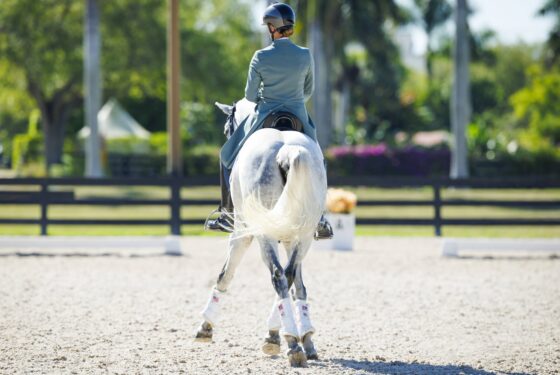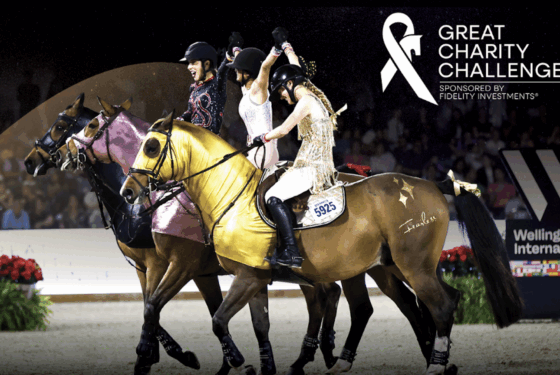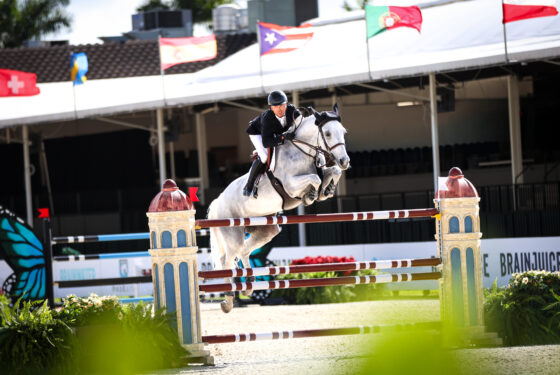This week, we had the opportunity to catch up with Nikko, Trevor, and Jim Ritter for a family edition of our rider spotlight series! Both Nikko and Trevor own and operate their own training and sales business, and this summer Nikko made his first Nations Cup appearance with Aquiles del Caribe Z. While both brothers focus exclusively on the equestrian industry, their father, Jim, is the founder and CEO of Printed Farms, a Wellington/based construction company specializing in 3D/printed buildings. Their most recent project happens to also be Nikko’s new farm and is the largest 3D/printed structure in the world. Continue reading to learn more about their businesses, their goals for the next year and more!
Trevor, Jim, and Nikko Ritter joined by Wendy Dixon, Nikko’s wife, Santa, and their son, Noah. (C)Hannah Stephens
Jim Ritter: How did you get your start in riding?
I grew up in Genessee Valley, New York. It’s old horse country; it has the longest continuing fox hunt in North America. I started riding at about seven years old with Michael Kelly, and Gordon Wright would come teach clinics. After I left high school, I went to England and rode for Robert Hall, who’s an Olympic trainer. After that, I was a working student for Denny Emerson.
Who taught you the most about horses and riding?
I don’t think I can pick just one person, but I can narrow it down to a generation. The generation that influenced me the most was the generation that evolved from horses to cars. I didn’t truly understand classical equitation until I rode with Robert Hall, and I didn’t understand shoeing until I shod with Bob Armstrong in England. In every part of your growth in your industry you learn things that were taught before, but you don’t understand until you apply it for many years.
When did you first start coming to Wellington, and what do you think about the growth the horse show has experienced over the years?
I think my first trip to Wellington was in the mid to late 1980s. Back then, it was just a dirt road, and they were showing out at the fairgrounds. I think the expansion has been spectacular. We never had anything like Saturday Night Lights when I was growing up, and we always wanted what the show has grown to be. I think the equestrian industry has evolved beyond our wildest dreams. No one ever dreamed that we would have barns like we do today or shows as big as WEF is.
Jim Ritter standing in front of the recently completed Nikko Ritter Show Stables. (C)Hannah Stephens
You own a construction company that specializes in 3D printing, and most recently completed the largest 3D/printed building in the world. What are your short/term and long/term goals for Printed Farms?
The short/term goals were to create a building system that’s viable and competitive with block, which we’ve done with the completion of Nikko’s new barn. Now, we’re trying to work with print/material people and people in the education systems, so kids learn how to build this building system that we developed, and then, of course, to develop better print machine systems that will mitigate the problems we’ve encountered utilizing this new technology. Long/term, we feel that 3D printing will eventually supplant the current systems in use.
Trevor Ritter: How do you balance your goals with the goals of your clients?
I think the best way to balance your goals with your client’s goals is to be very upfront with them about what you want from the partnership and ask what they want. A lot of headaches can be avoided if both parties are aware of expectations from the start. I’ve also found that, in general, clients want their trainers to do well. If you tell your clients that your goal is to jump grand prix classes, you should only accept those who support that goal. Building a supportive barn is key to achieving any goals, both from the trainer’s end and the client’s.
What key elements do you focus on with your students that you have learned from your own experience and training?
In general, riding comes down to feel, technique, and mental toughness, all of which can be improved through various exercises, be they mental exercises of changing how you approach a course to the physical exercises you put a horse through. The main thing I tell students when they’re getting frustrated is that riding is very simple, but very hard to do and to think in decades in terms of how long it will take to become a better rider rather than months. The average age of most Olympic riders is 40, so it takes time.
Trevor Ritter and Calvin Z (C)SportFot
You work with horses of all levels and ages. How does working with younger horses bring deeper meaning to success in the show ring?
There’s always a special feeling when you’ve worked with a horse for a long time and have been there for the hours and hours of setbacks, the people doubting you and the horse, and the relief and sense of accomplishment when it all clicks together, and the horse shows what was inside it all along. I’ve had people come up to me and say, “Wow, I didn’t think that horse could jump bigger than 1.30m,” after seeing it jump 1.40m at WEF. You have to believe in the horse and in yourself.
What are your immediate and long/term goals for your business?
My immediate goals are to sell some of my horses and start preparing for WEF. Long/term, I hope to keep expanding with quality horses and clients. As far as personal goals go, I would love to represent the US again in international competition, but that’s mostly dependent on sponsors, so we will see how it shakes out. I have a promising young horse, but he’s a few years away from that level.
Trevor Ritter and Elias Van Het Rozenhof (C)SportFot
Nikko Ritter: You grew up in Florida showing on the circuit and won the USET Talent Search as a junior. How did that experience prepare you to be a professional?
I think that travelling the circuit as a junior prepares you for the hustle and bustle and prepares you for all the nuances that you have to put into this sport as a professional. It really helped me realize how important a good support team is to succeed. There’s just so much that goes into you being successful, and as a junior you don’t appreciate how much goes into it until you get older and become a professional and must implement all those things.
I think that the equitation classes are good at teaching you line and track and how to manage the pressure and the expectations of multi/rounds and having to come back and produce, especially the finals. I think at the end of my junior career I had done USET Finals [East] six or seven times before I actually won. In the American system, there’s a lot of repetition, so you don’t get so nervous or star/struck when you get to the big classes. When you perform in a state of relaxation, you do better.
Nikko Ritter and Aquiles Del Caribe Z (C)SportFot
Before you started your own business, did you spend any time working for someone else?
After my junior years, I worked for McLain Ward, Missy Clark, Frank Madden and Peter Leone. I think each program had something different to offer. McLain’s system was the most robust, and it had a very family/like atmosphere to it that made you feel like you were part of a team. After a grand prix, McLain would come back and thank everyone at the barn, and we would share meals together all the time. Old Salem was more of a 40/50 horse barn, and you learned how to manage a lot of horses, and then North Run took that even higher since it was a 70/80 horse operation at that time. At Peter’s, I took a more active role in the training, so that was more client relations.
This summer, you represented the U.S. in the $2,023 FEI Jumping Nations Cup Uggerhalne CSIO3*. Tell me about that experience!
It was amazing; it was not only my first Nations Cup with Aquiles [Del Caribe Z], but it was also my first time representing the U.S. in a Nations Cup. I didn’t know what to expect, so I went over about a month early and did a grand prix a week after I got there so that if I ever get selected again, I know if I can fly over, give the horse a week and be able to show. We ended up second in that two/star grand prix in Europe, and then we took two weeks off and then went to Denmark.
Nikko Ritter and Aquiles Del Caribe Z (C)SportFot
What are your goals over the next couple of months?
My goal for this upcoming winter season is to step up into the four/star level and put in a good performance there. I think if he [Aquiles] can jump double/clear at 1.55m, there’s no reason he can’t be a five/star horse as well. They actually just released the FEI schedules for the winter. There’s a four/star in March that makes a lot of sense for us, so now I’m just trying to work back from that. I know I want to do a three/star the week before that and then move directly into the four/star. November and December will be a bit reliant on how he’s doing, but there are some three/star options during those months that I’m considering.
Nikko Ritter and his son, Noah. (C)Wellington International/Hannah Stephens





